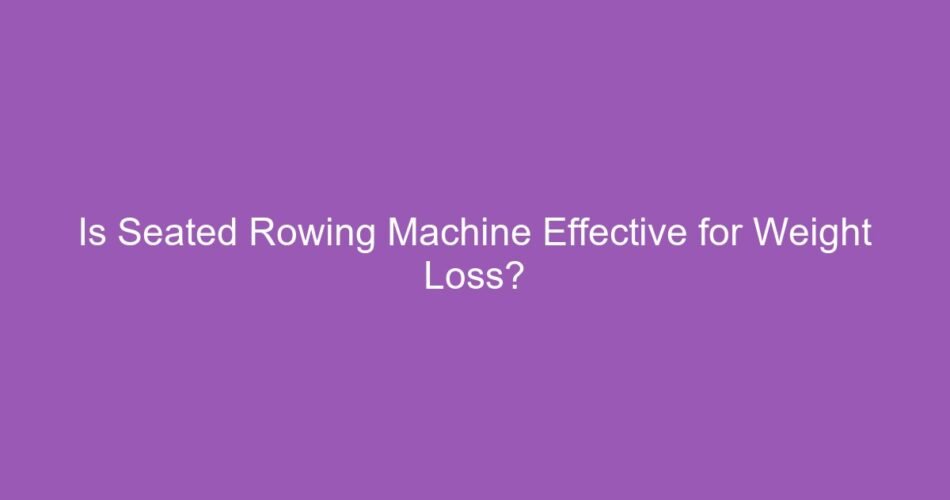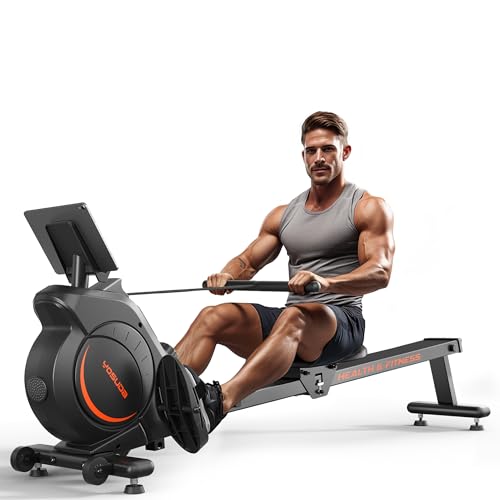Absolutely, the seated rowing machine is one of the most effective tools for shedding pounds quickly. It offers a powerful, low-impact, full-body workout that maximizes calorie expenditure and boosts metabolism for rapid weight management.
Is Seated Rowing Machine Effective for Weight Loss? The answer is a resounding yes. Rowing is often cited by fitness experts as the single most efficient piece of gym equipment available for simultaneously burning calories and building functional strength. This comprehensive machine engages roughly 86% of the body’s musculature in every stroke, making it a superior choice for increasing daily caloric expenditure and achieving sustainable weight loss goals.
Rowing’s Calorie Burn Potential
The seated rowing machine stands out among cardio equipment due to its incredibly high caloric expenditure rate. Effective weight loss hinges on creating a consistent calorie deficit (burning more calories than you consume), and the rowing machine makes achieving that deficit efficient and sustainable.
🛒 Recommended Product
Rowing is a highly energy-intensive activity because it forces the cardiovascular system to work hard while simultaneously requiring significant strength. According to data compiled by the American Council on Exercise (ACE), a person weighing 185 pounds can burn approximately 377 calories in just 30 minutes of moderate rowing. This is comparable to the caloric demands of vigorous cycling or stair-climbing.
This high rate of calorie burn stems from the dynamic need for energy from both anaerobic (muscle strength) and aerobic (cardio endurance) systems. Because the body cannot rely solely on a single muscle group, the heart must pump oxygenated blood to the upper body, lower body, and core simultaneously. This widespread energy demand leads to a higher metabolic rate both during and after the exercise session.
Total Body Activation: Why Rowing Excels
What truly distinguishes the rower and helps answer the question of how effective the seated rowing machine is for weight loss is its ability to deliver a true total body workout. Most traditional cardio machines, such as the treadmill or stationary bike, focus primarily on the lower body. Rowing, however, systematically engages muscle groups across all major body regions throughout the four phases of the stroke: the catch, the drive, the finish, and the recovery.
The distribution of muscle effort during a proper rowing stroke is essential for maximizing fat loss:
- 60% Legs: The power phase, or “the drive,” is initiated by pressing through the feet, engaging the glutes, hamstrings, and quads. These are the largest muscle groups in the body and require the most fuel to operate.
- 20% Core: The abdominals and lower back stabilizers work constantly to connect the powerful lower-body drive to the upper-body pull. A strong core connection is vital for transferring power and maintaining efficient energy use.
- 20% Upper Body: The lats (back muscles), rhomboids, trapezius, biceps, and forearms complete the stroke by pulling the handle into the chest.
Activating these large muscle groups simultaneously is crucial for weight management because muscle tissue is metabolically expensive. By building and engaging muscle across the entire body, you increase your basal metabolic rate, meaning you burn more calories even while resting.
Maximizing Weight Loss with Rowing Workouts
While simply rowing provides immense benefits, applying strategic training techniques can significantly boost fat loss results. Consistency and intensity are the two main drivers of success when utilizing a seated rowing machine.
Leveraging HIIT Training
One of the most powerful tools for accelerating weight loss on the rower is incorporating High-Intensity Interval Training (HIIT). HIIT involves alternating short bursts of maximal effort (such as rowing at a sprint pace for 30 seconds) with periods of low-intensity recovery (rowing slowly for 60 seconds).
The main benefit of HIIT is the “afterburn effect,” technically known as Excess Post-exercise Oxygen Consumption (EPOC). After intense exercise, the body requires extra oxygen to recover, repair muscles, and return to a resting state. This process keeps the metabolism elevated for hours, resulting in additional caloric burn long after the workout is finished. Because rowing is a safe, low impact fitness activity, it is uniquely suited for the high efforts required in HIIT without risking joint damage.
🛒 Recommended Product
The Importance of Technique
To ensure the maximum benefit and reduce the risk of injury, proper technique must be prioritized. If the focus is shifted too heavily toward the arms or back, the powerful leg muscles are underutilized, significantly reducing the efficiency and total energy demand of the workout.
Fitness experts recommend adhering to the 60-20-20 rule when performing the drive: 60% power from the legs, 20% from the core, and 20% from the arms. This sequence guarantees that the largest muscles are responsible for the majority of the power output, ensuring the highest possible rate of caloric expenditure.
Comparing Rowing to Other Cardio Machines
Many individuals assessing exercise options are curious about how the seated rowing machine compares to popular alternatives like the elliptical, cycling machine, or treadmill running. The rower’s unique combination of cardio and resistance training places it in a superior category for rapid, safe weight loss.
A major advantage of rowing is its low-impact nature. The fluid, guided motion minimizes stress on load-bearing joints—the knees, ankles, and hips—making it an excellent choice for individuals managing joint pain, rehabilitating injuries, or those who are significantly overweight and require safer exercise options. Unlike running, which involves repeated high impact forces, rowing allows for high-intensity, high-volume workouts with minimal risk of overuse injuries.
The following table provides a comparison of the typical caloric output of a seated rowing machine versus other common gym apparatuses:
| Cardio Machine | Primary Focus | Impact Level | Estimated Calories Burned (30 min, 185 lbs)* |
|---|---|---|---|
| Seated Rower | Full Body (Cardio + Strength) | Low | 377 |
| Treadmill (Running) | Lower Body (Cardio) | High | 444 |
| Elliptical Trainer | Full Body (Lower intensity cardio) | Low | 324 |
| Stationary Bike (Vigorous) | Lower Body (Cardio) | Low | 377 |
*Estimates are based on sustained vigorous effort; actual output varies by intensity and personal metabolic rate (Source: Harvard Medical School / ACE).
As the data shows, the seated rower matches the caloric burn of vigorous stationary biking and approaches the levels of running, but without the corresponding high impact on the joints. This makes it a sustainable, long-term option for weight management and fitness.
🛒 Recommended Product
The seated rowing machine is indisputably one of the most effective tools for weight loss due to its ability to harness high caloric burn and total-body muscle engagement. By efficiently combining cardiovascular demands with resistance, it efficiently creates the calorie deficit necessary for long-term weight management while offering the critical benefit of being a low-impact exercise.
Scientific References & Research
The following peer-reviewed research papers provide additional scientific context:
-
A Temraz (2022).
The effectiveness of using a rowing machine for developing aerobic capacity and technical skills in rowing
[External Link] -
K Miyawaki et al. (2013).
Evaluation of the rowing machine with pressure of seat and sole
[External Link] -
JB Cronin et al. (2007).
Kinematics and kinetics of the seated row and implications for conditioning
[External Link]
Note: External research links are provided for educational purposes and do not necessarily represent endorsement.
Frequently Asked Questions About Is Seated Rowing Machine Effective for Weight Loss?
Q. Is rowing considered an effective form of cardiovascular exercise for burning fat?
A. Yes, rowing is an incredibly effective form of full-body cardiovascular exercise that efficiently burns fat. Consistent rowing at moderate to high intensity pushes the body into an aerobic zone, which is optimal for utilizing stored fat as the primary fuel source. Furthermore, its continuous, rhythmic motion can be sustained for longer durations compared to high-impact exercises, maximizing the total duration of fat-burning activity.
Q. How important is workout intensity and duration on the rowing machine for maximizing weight loss results?
A. Workout intensity and duration are crucial determinants of weight loss success on the rower. Incorporating High-Intensity Interval Training (HIIT) allows for maximum calorie expenditure in shorter periods and elevates Excess Post-exercise Oxygen Consumption (EPOC), continuing to burn calories post-workout. However, maintaining consistent, longer sessions (30-45 minutes) at a moderate pace is also vital for accumulating the total calorie deficit necessary for sustainable weight loss.
Q. Can rowing alone be sufficient for achieving significant weight loss, or should it be combined with other factors?
A. While rowing is an excellent tool for calorie burning and muscle conditioning, relying solely on it is usually insufficient for significant, sustainable weight loss. Optimal results are achieved when regular rowing workouts are combined with a balanced, calorie-controlled nutritional plan, which is the cornerstone of weight management. Combining rowing with light strength training also helps preserve lean muscle mass, which is key for maintaining a higher resting metabolic rate.
Q. Compared to other popular gym machines (like treadmills or ellipticals), how does the rowing machine rate for weight loss efficiency?
A. The rowing machine often rates higher than treadmills or ellipticals for overall weight loss efficiency because it provides a truly full-body workout. Unlike running or cycling, which primarily target the lower body, rowing recruits the legs, core, back, and arms in every stroke. This superior muscle engagement leads to a higher overall metabolic demand and, consequently, a greater potential for calorie and fat burning per unit of time.
Q. Does the low-impact nature of the seated rowing machine make it better for overweight individuals trying to lose weight?
A. Absolutely, the low-impact nature of the seated rowing machine makes it an ideal choice for overweight individuals, especially those with joint issues. Because the motion is smooth and controlled while seated, it places very minimal stress on the knees, hips, and ankles compared to high-impact activities like running. This accessibility allows individuals to engage in intense, effective calorie-burning workouts without risking injury or exacerbating existing joint pain.
Q. What role does building muscle mass through rowing play in the long-term maintenance of weight loss?
A. Building muscle mass through rowing is fundamental for the long-term maintenance of weight loss. Muscle tissue is metabolically active, meaning it burns more calories at rest than fat tissue. By strengthening major muscle groups, rowing increases the overall lean muscle mass, effectively raising the body’s resting metabolic rate (RMR), making it easier to manage weight and prevent weight regain over time.
Related Articles
Do Weight Loss Vibration Machines Work?
Vibration machines alone are not magic diet tools Do Weight Loss Vibration Machines Work The consensus from clinical trials suggests they are effectiv…
Do Rowing Machines Help with Weight Loss?
Do Rowing Machines Help with Weight Loss? Rowing machines are an outstanding tool for significant weight loss, uniquely combining high-intensity cardi…
Do Elliptical Machines Work for Weight Loss?
Ellipticals offer a powerful, low-impact solution for achieving aggressive weight management goals. Find out exactly how many calories you can burn an…
When you purchase a product through Amazon links on EllipticalKing.com, we may earn a small commission at no extra cost to you. This helps support the site and keep our content free.




